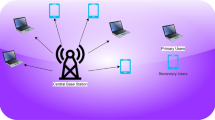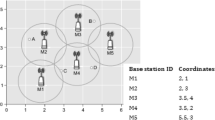Abstract
Mobile computing is the way of the future, as evident by such initiatives as Bluetooth, Iceberg and HomeRF. However, for mobile computing to be successful, an obvious layer, the MAC layer, must be efficient in channel access and reservation. Therefore, in-depth understanding is needed of the wireless MAC layer if wireless computing is to takeoff. Many random access wireless MAC protocols have been proposed and even standardized. However, there has yet been an attempt to understand why certain designs are used and what makes certain protocols better than others. In this paper, we survey several popular, contemporary, wireless, random access MAC protocols and determine the effects behind the design choices of these protocols.
Similar content being viewed by others
References
R. Bagrodia, R. Meyerr et al., PARSEC: A parallel simulation environment for complex system, Computer Magazine (1998).
V. Bharghavan, A. Demers, S. Shenker and L. Zhang, MACAW: A media access protocol for wireless LAN's, in: ACM SIGCOMM (1994).
M. Correa and K. Tang, Isolation of wireless ad hoc medium access mechanisms under UDP, 990025 (May 28, 1999).
C. Fullmer and J.J. Garcia-Luna-Aceves, Floor acquisition multiple access (FAMA) for packet radio networks, Computer Communication Review 25(4) (October 1995). Also in: ACM SIGCOMM’ 95, Cambridge, MA, USA (28 August-1 September 1995).
M. Gerla, K. Tang and R. Bagrodia, TCP performance in wireless multihop networks, in: Proceedings of IEEE WMCSA’ 99 (February 1999).
J. Haartsen, M. Naghshineh, J. Inouye, O.J. Joeressen and W. Allen, Bluetooth: Vision, goals, and architecture, ACM SIGMOBILE Mobile Computing and Communications Review 2(4) (October 1998) 38–45.
IEEE 802.11, Wireless LAN Medium Access Control (MAC) and Physical Layer (PHY) specifications, Draft standard, P802.11/D5.0 (July 1996).
A. Joseph, B.R. Badrinath and R. Katz, A case for services over cascaded networks, in: First ACM/IEEE International Conference on Wireless and Mobile Multimedia (WoWMoM’ 98), Dallas, TX (October 1998).
J. Jubin and J.D. Tornow, The DARPA packet radio network protocols, Proceedings of the IEEE (January 1987).
P. Karn, MACA - a new channel access method for packet radio, in: ARRL/CRRL Amateur Radio 9th Computer Networking Conference, ARRL (1990).
K.J. Negus, J. Waters, J. Tourrilhes, C. Romans, J. Lansford and S. Hui, HomeRF and SWAP: Wireless networking for the connected home, ACM SIGMOBILE Mobile Computing and Communications Review 2(4) (October 1998) 28–37.
A.S. Tanenbaum, Computer Networks, 3rd ed. (Prentice Hall, Englewood Cliffs, NJ, 1996).
X. Zeng, R. Bagrodia and M. Gerla, GloMoSim: a library for the parallel simulation of large-scale wireless networks, PADS (1998).
Author information
Authors and Affiliations
Rights and permissions
About this article
Cite this article
Tang, K., Correa, M. & Gerla, M. Effects of Ad Hoc MAC Layer Medium Access Mechanisms under TCP. Mobile Networks and Applications 6, 317–329 (2001). https://doi.org/10.1023/A:1011422510611
Issue Date:
DOI: https://doi.org/10.1023/A:1011422510611




